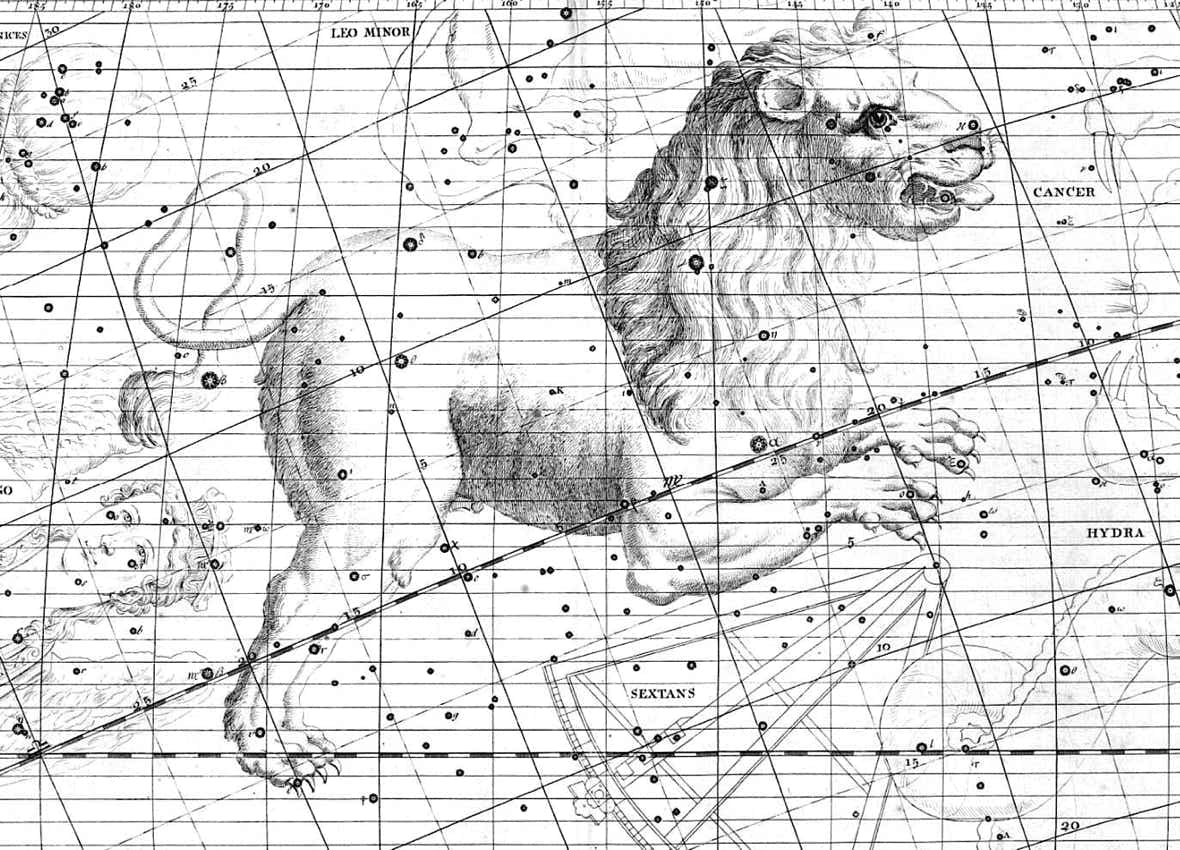
Genitive: Leonis
Abbreviation: Leo
Size ranking: 12th
Origin: One of the 48 Greek constellations listed by Ptolemy in the Almagest
Greek name: Λέων (Leon)
Eratosthenes and Hyginus both affirm that the lion was placed in the sky because it is the king of beasts. Mythologically speaking, this is reputed to be the lion of Nemea, slain by Heracles as the first of his 12 labours. Nemea is a town some way south-west of Corinth. There the lion lived in a cave with two mouths, emerging to carry off the local inhabitants, who were becoming scarce. The lion was an invulnerable beast of uncertain parentage; it was variously said to have been sired by the dog Orthrus, the monster Typhon, or even to be the offspring of Selene, the Moon goddess. Its skin was proof against all weapons, as Heracles found when he shot an arrow at the lion and saw that it simply bounced off.
Undeterred, Heracles heaved up his mighty club and made after the animal, which retreated into its cave. Heracles blocked up one of the entrances and went in through the other. He grappled with the lion, locking his huge arm around its throat and choking the beast to death. Heracles carried the lion’s corpse away in triumph on his shoulders. Later he used the creature’s own razor-sharp claws to cut off its pelt, which he wore as a cloak. The lion’s gaping mouth bobbing above his own head made Heracles look more fearsome than ever.
Leo shown ready to pounce in the Atlas Coelestis of John Flamsteed (1729).
In his chest can be found the bright star Regulus, labelled Alpha. Leo lies
on the Sun’s path around the sky, the ecliptic, here marked by a dashed line.
Regulus, the little king
The Greeks knew the constellation as Λέων, simply ‘lion’, and it is easy to make out the shape of a crouching lion among its stars. The head and chest are outlined by six stars arranged in the shape of a sickle. At the foot of the Sickle, marking the lion’s heart (according to Ptolemy’s description), is the constellation’s brightest star, Alpha Leonis, which we call Regulus, Latin for ‘little king’. Ptolemy in the Almagest called it Βασιλίσκος (Basiliskos, or Basiliscus in Latin transliteration) which means the same. The name Basiliskos first appeared in print with the Greek writer Geminus, roughly two centuries before Ptolemy; the earlier writers Aratus and Eratosthenes gave the star no name at all, but the Babylonians knew it as LUGAL, ‘king’. The Arabs called it Qalb al-Asad, meaning heart of the lion, or simply al-Malikī, the royal or kingly one.
According to the star name expert Paul Kunitzsch, the Latin name Regulus first appeared in several publications in the early 16th century by three different scholars who each seem to have derived it independently from the Greek: Petrus Apianus (Peter Apian) in 1524 and 1533; George of Trebizond, in a translation of the Almagest published in 1528; and, earliest of all, by the German mathematician Johannes Werner (1468–1522) in a treatise on the movement of the celestial sphere published in 1522. One of the first to adopt it was Copernicus, who is sometimes wrongly said to have invented the name. Johann Bode, on his chart of Leo, added the word Kelb, from the Arabic kalb or qalb, meaning heart.
Other stars of Leo, and a cluster
On the tip of the tail is the star Beta Leonis, called Denebola from the Arabic dhanab al-asad for ‘the lion’s tail’. It was also known to the Arabs as al-Ṣarfa, a name referring to change, in this case the change of seasons: its rising at dawn before the Sun (heliacal rising) in autumn marked the onset of cooler weather, while its setting at dawn in the spring heralded the arrival of hotter weather. Bode in his Uranometria used the spelling Zerphah rather than Ṣarfa.
Gamma Leonis is called Algieba, from the Arabic al-jabha meaning ‘the forehead’; this seems puzzling, since according to Ptolemy it lies in the lion’s neck, but the Arabs saw here a very much larger lion than the one visualized by the Greeks, extending from Gemini to Virgo along the ecliptic and north into Ursa Major. Gamma Leonis is a celebrated double star, consisting of a pair of yellow giant stars divisible in small telescopes. Delta Leonis is called Zosma from a Greek word meaning ‘girdle’ or ‘loin cloth’, mistakenly applied to this star in Renaissance times; in fact it lies in the lion’s rump.
Ptolemy listed eight ‘unformed’ stars lying outside the body of Leo. Three of them formed a triangle to the north of the lion’s tail, marking the corners of what Ptolemy referred to as a ‘nebulous mass’. This was the large open cluster we know as Melotte 111, now part of Coma Berenices which was made into a separate constellation in the 16th century. The three 'unformed' stars are now known as Gamma, 7, and 23 Comae Berenices. To the last of these Ptolemy added the curious description ‘shaped like an ivy leaf’, presumably referring to the overall shape of the trio and the nebulous mass within. Of the other unformed stars, one was appropriated by Hevelius for his new constellation of Leo Minor, where it is now known as 41 LMi, while the other four were absorbed into Leo.
Chinese associations
On Chinese star charts the Sickle of Leo is recognizable, but as part of a rather different constellation figure. From the top of the Sickle extended a snaking line that took in Lambda and Kappa Leonis before heading north into Lynx. In all, 17 stars were involved in the chain, including Regulus and Omicron and Rho Leonis either side of it; the whole formation was known as Xuanyuan, the Yellow Dragon (or, according to some, the spirit of Huangdi, the Yellow Emperor).
Denebola (Beta Leonis) was not part of Xuanyuan, but nevertheless was connected to it in myth. In China, Denebola was called Huangdi, the Yellow Emperor. This name comes from a legendary ruler who is credited with being the main founder of Chinese civilization; the Yellow Dragon (Xuanyuan) snaking among the other stars of Leo was said to be his image immortalized in the sky. So Xuanyuan, with the nearby Huangdi, is one of the few Chinese star patterns that can boast a mythology comparable to that of the Greek constellations.
Four faint stars to the north, south, west, and east of Huangdi governed the four seasons. Taken together, Huangdi and its companions formed a group known as Wudi, the Five Emperors (or deities). Their chariots were represented by the five stars that outline the shape of Auriga.
To the north of this group of five celestial gods lay the real ruling Emperor’s heir or crown prince, Taizi, represented by 93 Leonis, with Congguan, his personal assistant, hovering at a respectful distance (92 Leonis), and a bodyguard, Huben (72 Leonis), keeping watch. Wudi, Taizi, and Congguan fell within a larger area called Taiwei, representing a court where the Chinese Emperor met with his privy council, which extended into neighbouring Virgo. One of the boundary walls of Taiwei was marked out by a chain of five stars heading southwards from Delta via Theta, Iota, and Sigma Leonis to Beta Virginis.
A fainter line of four stars stretching northwards from Leo into Leo Minor formed Shaowei, seen as either a delegation of nobility welcoming Huangdi as he approached Taiwei, or a retinue of scholarly advisors. Sources differ as to the identity of these stars, but they could have been 53 Leonis to 41 Leonis Minoris. This same line later became known as Changyuan, an outer protective barrier for Taiwei.
Among the smaller constellations that the Chinese imagined in this area, Xi Leonis and two other nearby stars were Jiuqi, the banner of a wine maker or merchant, possibly associated with the kitchen (Waichu) in Hydra to the south. The stars Chi, 58, and 59 Leonis straddling the ecliptic represented Lingtai, the astronomical observatory, which would have been a simple lookout tower like this one. Upsilon Leonis and two other stars formed Mingtang, ‘bright hall’, an administrative centre where the Emperor announced the annual calendar of events at the start of each year; the ‘brightness’ in its title might be a reference to the luminous presence of the Emperor himself.
© Ian Ridpath. All rights reserved
The first known use of the Latin name Regulus was made by the German mathematician Johannes Werner in a treatise on the movement of the celestial sphere, De motu octavae sphaerae, published in 1522.
Johann Bode gave Regulus the alternative name Kelb, from the Arabic meaning heart, on his Uranographia atlas of 1801.
Bode gave Beta Leonis the alternative name Zerpha, a transcription of the Arabic al-Ṣarfa that he evidently garnered from Johann Gottfried Eichhorn’s Allgemeine Bibliothek der Biblischen Literatur of 1787. The name refers to a weather change, since the star’s morning rising and setting was a guide to the changing seasons.






